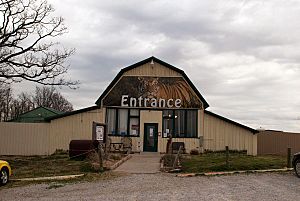Turpentine Creek Wildlife Refuge facts for kids
Turpentine Creek Wildlife Refuge (TCWR) is a special place in Eureka Springs, Arkansas. It's a big area, about 459 acres, that helps big cats and other animals. These animals have been hurt, left alone, or not cared for properly.
The refuge is home to over 100 animals. Most of them are tigers, but you can also find lions, leopards, cougars, bobcats, and even ligers. There are also black bears, a grizzly bear, servals, a monkey, and a coatimundi. Turpentine Creek is a safe home where these animals can live happily.
In 2015, Turpentine Creek earned a special "Verified Status" from the Global Federation of Animal Sanctuaries. This means they meet high standards for animal care. They are also a member of the American Association of Zoo Keepers.
Helping More Animals
In 2012, Turpentine Creek rescued 34 big cats all at once. These cats came from a place that was breeding them. To make space for so many new animals, they built a new area. This new part is called "Rescue Ridge."
Many of these rescued cats were not used to being around people. To keep them calm and safe, "Rescue Ridge" is not open to visitors. This helps the animals feel less stressed.
Making Bigger Homes
Turpentine Creek has been working hard to make the refuge even better. The older part of the refuge, called the "Compound," used to have smaller cages with concrete floors. Over the past 14 years, the refuge has built much bigger, grassy homes for the animals. These new habitats are about 1/4 acre to 1/2 acre in size.
By September 16, 2015, all the animals had moved out of the old concrete cages. The very next day, on September 17, 2015, they started tearing down the old "Compound" area. This made way for even more natural and spacious habitats.
On-Site Animal Hospital
Turpentine Creek has its own special hospital right there at the refuge. This is a big help for the animals. If an animal needs medical care, the vets can treat them right away.
Having the hospital on-site means the animals don't have to travel. This makes getting medical help much easier and less stressful for them. It also keeps both the animals and the people who care for them safer.


